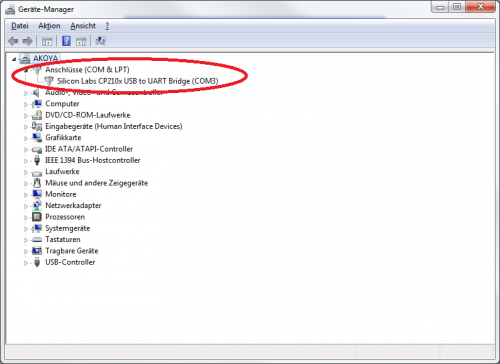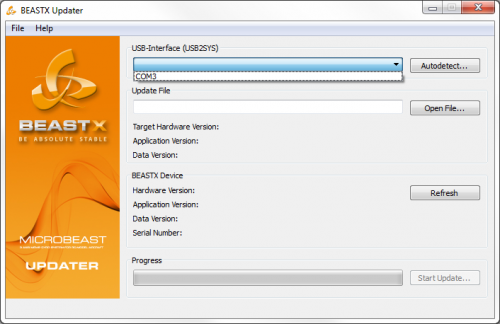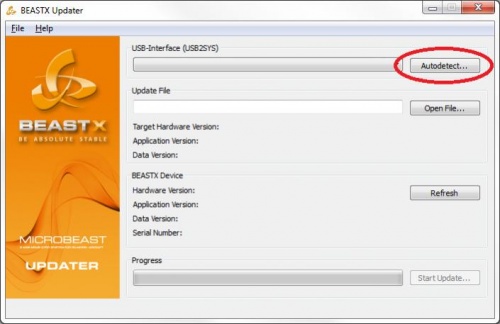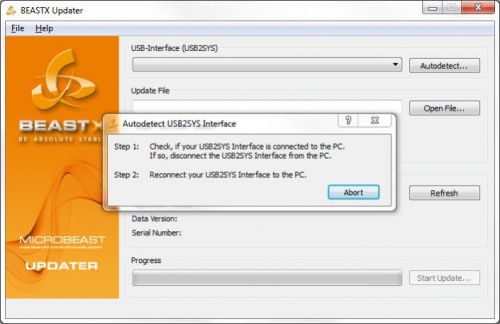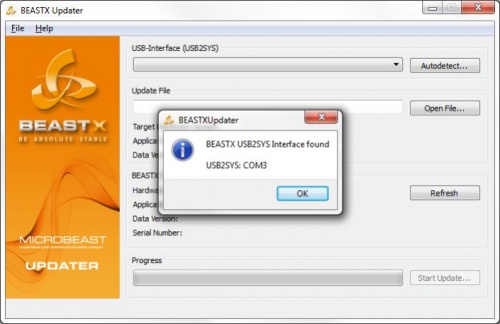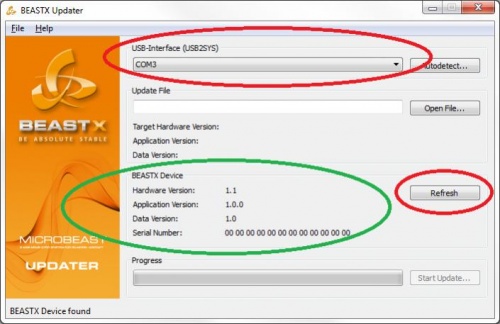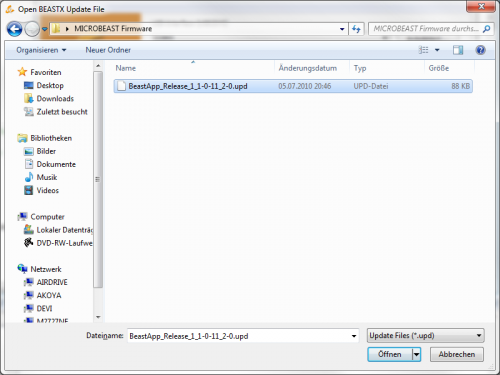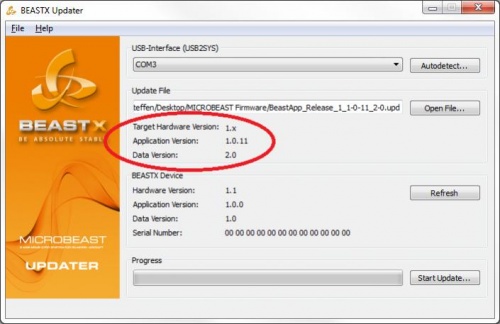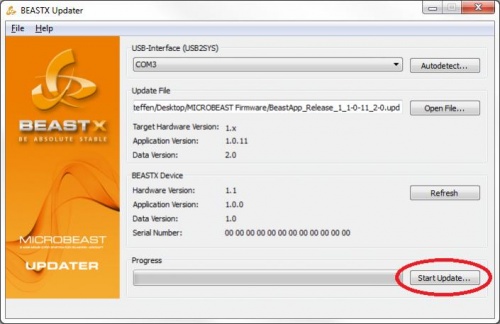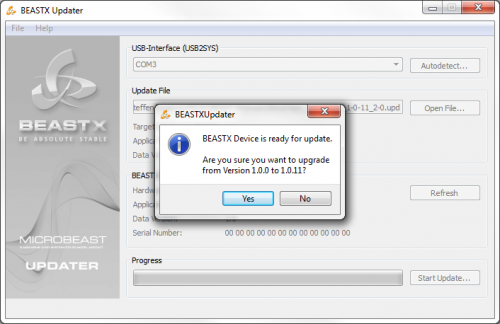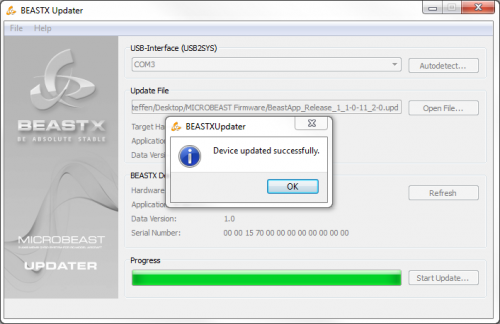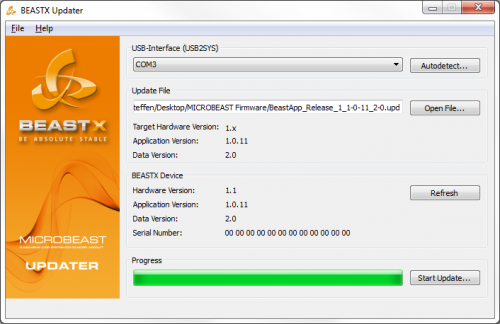Difference between revisions of "BEASTX Updater Classic"
Shornstein (talk | contribs) |
Shornstein (talk | contribs) (Marked this version for translation) |
||
| Line 2: | Line 2: | ||
<br /> | <br /> | ||
<translate> | <translate> | ||
| − | ===1. Uninstall existing Software (Windows only)=== | + | ===1. Uninstall existing Software (Windows only)=== <!--T:1--> |
Uninstall any existing BEASTXUpdater/Microsettings installation prior to install the BEASTXSoftware bundle. | Uninstall any existing BEASTXUpdater/Microsettings installation prior to install the BEASTXSoftware bundle. | ||
| − | ===2. Download Update Software and Install=== | + | ===2. Download Update Software and Install=== <!--T:2--> |
| + | <!--T:3--> | ||
Supported operating systems are: | Supported operating systems are: | ||
| − | Windows (XP, Vista, 7, 8, 8.1) | + | <!--T:4--> |
| + | Windows (XP, Vista, 7, 8, 8.1) | ||
MacOS 10.6.x and later | MacOS 10.6.x and later | ||
| − | ===3. Driver installation=== | + | ===3. Driver installation=== <!--T:5--> |
Windows: | Windows: | ||
The driver installation will not be launched automatically during setup. | The driver installation will not be launched automatically during setup. | ||
The installer will be copied and a link to it is added to the BEASTX group in Start-Menu. Do not connect the USB2SYS interface to the computer unless you did not perform the driver installation. After the installation when you connect the interface to the PC, Windows will recognize the device and install it as a new device. | The installer will be copied and a link to it is added to the BEASTX group in Start-Menu. Do not connect the USB2SYS interface to the computer unless you did not perform the driver installation. After the installation when you connect the interface to the PC, Windows will recognize the device and install it as a new device. | ||
| + | <!--T:6--> | ||
MacOS: | MacOS: | ||
The driver is inside the Disk-Image and must be installed manually. | The driver is inside the Disk-Image and must be installed manually. | ||
| − | ===4. Validate driver installation (Windows only)=== | + | ===4. Validate driver installation (Windows only)=== <!--T:7--> |
After successful installation of the driver, when the USB2SYS-Interface is connected to the PC, you must be able to find following entry in the Windwos Device Manager: | After successful installation of the driver, when the USB2SYS-Interface is connected to the PC, you must be able to find following entry in the Windwos Device Manager: | ||
| + | <!--T:8--> | ||
[[File:Step 4.png|500px]] | [[File:Step 4.png|500px]] | ||
| + | <!--T:9--> | ||
The name COM3 may be different on your PC. This entry must disappear when you disconnect the USB2SYS-Interface from the PC, and reappear when you connect it again. | The name COM3 may be different on your PC. This entry must disappear when you disconnect the USB2SYS-Interface from the PC, and reappear when you connect it again. | ||
| + | <!--T:10--> | ||
To access the device manager under windows 7 type devmgmt.msc in the Startmenu's search bar. Alternatively you can enter the computer properties by pressing and holding the START key on the keyboard and addtionaly pressing the PAUSE key. Then click on device manager in the upper left corner of the appearing window. | To access the device manager under windows 7 type devmgmt.msc in the Startmenu's search bar. Alternatively you can enter the computer properties by pressing and holding the START key on the keyboard and addtionaly pressing the PAUSE key. Then click on device manager in the upper left corner of the appearing window. | ||
| − | ===5. Start BEASTXUpdater=== | + | ===5. Start BEASTXUpdater=== <!--T:11--> |
IMPORTANT: The MICROBEAST will not be powered from the USB2SYS-Interface, so the MICROBEAST must be supplied with power from a different source BEFORE you connect it to the PC, e.g. simply switch on tx and rx as you would go flying (on electric helis take care of the motor!). | IMPORTANT: The MICROBEAST will not be powered from the USB2SYS-Interface, so the MICROBEAST must be supplied with power from a different source BEFORE you connect it to the PC, e.g. simply switch on tx and rx as you would go flying (on electric helis take care of the motor!). | ||
| + | <!--T:12--> | ||
The cable from the interface goes into the Microbeast's [SYS] port. Watch out for correct polarity on both devices. | The cable from the interface goes into the Microbeast's [SYS] port. Watch out for correct polarity on both devices. | ||
| + | <!--T:13--> | ||
If the COM-Port, to which the USB2SYS-Interface has been assigned by windows, is known you can directly choose it from the list of available interfaces: | If the COM-Port, to which the USB2SYS-Interface has been assigned by windows, is known you can directly choose it from the list of available interfaces: | ||
| + | <!--T:14--> | ||
[[File:Step 5_1.png|500px]] | [[File:Step 5_1.png|500px]] | ||
| + | <!--T:15--> | ||
If the COM-Port is not known you can use the "Autodetect…" function: | If the COM-Port is not known you can use the "Autodetect…" function: | ||
| + | <!--T:16--> | ||
[[File:Step 5_2.jpg|500px]] | [[File:Step 5_2.jpg|500px]] | ||
| + | <!--T:17--> | ||
[[File:Step 5_3.jpg|500px]] | [[File:Step 5_3.jpg|500px]] | ||
| + | <!--T:18--> | ||
When the dialog is shown, disconnect the USB2SYS-Interface from the PC (if already connected) and reconnect it again. | When the dialog is shown, disconnect the USB2SYS-Interface from the PC (if already connected) and reconnect it again. | ||
The Autodetect-function will only work if the driver was installed successfully. | The Autodetect-function will only work if the driver was installed successfully. | ||
| + | <!--T:19--> | ||
After a successful detection the BEASTXUpdater will tell you which COM-Port was detected: | After a successful detection the BEASTXUpdater will tell you which COM-Port was detected: | ||
| + | <!--T:20--> | ||
[[File:Step 5_4.jpg|500px]] | [[File:Step 5_4.jpg|500px]] | ||
| − | ===6. Detect connected BEASTX device=== | + | ===6. Detect connected BEASTX device=== <!--T:21--> |
After you selected a COM-Port the BEASTXUpdater will automatically try to identify the unit connected to it. | After you selected a COM-Port the BEASTXUpdater will automatically try to identify the unit connected to it. | ||
| + | <!--T:22--> | ||
If the MICROBEAST/Trajectory/AR7200BX was not connected at this moment you can manually force a new detection by pressing the "Refresh" button (or "Connect" when using the MicroSettings Software). | If the MICROBEAST/Trajectory/AR7200BX was not connected at this moment you can manually force a new detection by pressing the "Refresh" button (or "Connect" when using the MicroSettings Software). | ||
| + | <!--T:23--> | ||
If the correct COM-Port was chosen (red), and the MICROBEAST is connected to the USB2SYS-Interface, some information (green) of this MICROBEAST will be shown in the "BEASTX Device" section: | If the correct COM-Port was chosen (red), and the MICROBEAST is connected to the USB2SYS-Interface, some information (green) of this MICROBEAST will be shown in the "BEASTX Device" section: | ||
| + | <!--T:24--> | ||
[[File:Step 6.jpg|500px]] | [[File:Step 6.jpg|500px]] | ||
| + | <!--T:25--> | ||
At this moment Hardware-Version 1.1 and 1.2 are existing. | At this moment Hardware-Version 1.1 and 1.2 are existing. | ||
Application-Version is the actually installed firmware of the MICROBEAST (in this case 1.0.0) | Application-Version is the actually installed firmware of the MICROBEAST (in this case 1.0.0) | ||
| Line 73: | Line 92: | ||
Serial-Number is a unique identifier for each MICROBEAST. | Serial-Number is a unique identifier for each MICROBEAST. | ||
| − | ===7. Select Update-File=== | + | ===7. Select Update-File=== <!--T:26--> |
If the MICROBEAST was successfully identified you can go on with selecting an Update-File (if you don't have a firmware update file yet, have a look [[Update_request|here]]). | If the MICROBEAST was successfully identified you can go on with selecting an Update-File (if you don't have a firmware update file yet, have a look [[Update_request|here]]). | ||
| + | <!--T:27--> | ||
"Open File…" button opens a dialog where you can choose the Update-File. | "Open File…" button opens a dialog where you can choose the Update-File. | ||
| + | <!--T:28--> | ||
[[File:Step 7_1.png|500px]] | [[File:Step 7_1.png|500px]] | ||
| + | <!--T:29--> | ||
Or you can just drag'n'drop an Update-File from the Explorer to the Main window of the BEASTXUpdater. | Or you can just drag'n'drop an Update-File from the Explorer to the Main window of the BEASTXUpdater. | ||
| + | <!--T:30--> | ||
An Updates-File can only be loaded if it is free of damage, complete and has the mentioned "upd" ending. | An Updates-File can only be loaded if it is free of damage, complete and has the mentioned "upd" ending. | ||
| + | <!--T:31--> | ||
Application-Version, Data-Version and Target-Hardware will be shown if the file was loaded successfully: | Application-Version, Data-Version and Target-Hardware will be shown if the file was loaded successfully: | ||
| + | <!--T:32--> | ||
[[File:Step 7_2.jpg|500px]] | [[File:Step 7_2.jpg|500px]] | ||
| + | <!--T:33--> | ||
Only a compatible "Target Hardware Version" can be installed on a MICROBEAST. | Only a compatible "Target Hardware Version" can be installed on a MICROBEAST. | ||
The firmware version in the Update-File will be shown next to "Application Version" (in this case 1.0.11). | The firmware version in the Update-File will be shown next to "Application Version" (in this case 1.0.11). | ||
| + | <!--T:34--> | ||
The format of settings will be shown next to "Data Version". | The format of settings will be shown next to "Data Version". | ||
IMPORTANT: If the major version of the "Data Version" is different between the actual and new firmware, then the Basic-Setup has to be done again after the update. | IMPORTANT: If the major version of the "Data Version" is different between the actual and new firmware, then the Basic-Setup has to be done again after the update. | ||
| − | ===8. Perform Update=== | + | ===8. Perform Update=== <!--T:35--> |
If a valid COM-Port is selected an a valid Update-File was loaded, the "Start Update…" button will be enabled: | If a valid COM-Port is selected an a valid Update-File was loaded, the "Start Update…" button will be enabled: | ||
| + | <!--T:36--> | ||
[[File:Step 8_1.jpg||500px]] | [[File:Step 8_1.jpg||500px]] | ||
| + | <!--T:37--> | ||
After pressing the "Start Update…" button, the actual firmware version, and the new target firmware version will be shown: | After pressing the "Start Update…" button, the actual firmware version, and the new target firmware version will be shown: | ||
| + | <!--T:38--> | ||
[[File:Step 8_2.png||500px]] | [[File:Step 8_2.png||500px]] | ||
| + | <!--T:39--> | ||
Press "Yes" to start the update. | Press "Yes" to start the update. | ||
| + | <!--T:40--> | ||
After a successful update a message will be displayed: | After a successful update a message will be displayed: | ||
| + | <!--T:41--> | ||
[[File:Step 8_3.png||500px]] | [[File:Step 8_3.png||500px]] | ||
| + | <!--T:42--> | ||
After your confirmation with "Ok" BEASTXUpdater will detect the version information of the connected MICROBEAST again. | After your confirmation with "Ok" BEASTXUpdater will detect the version information of the connected MICROBEAST again. | ||
| + | <!--T:43--> | ||
[[File:Step 8_4.png||500px]] | [[File:Step 8_4.png||500px]] | ||
| + | <!--T:44--> | ||
You can refresh this information using the "Refresh" button. | You can refresh this information using the "Refresh" button. | ||
| + | <!--T:45--> | ||
Your MICROBEAST is now updated to the latest firmware. | Your MICROBEAST is now updated to the latest firmware. | ||
</translate> | </translate> | ||
Revision as of 16:37, 16 December 2013
1. Uninstall existing Software (Windows only)
Uninstall any existing BEASTXUpdater/Microsettings installation prior to install the BEASTXSoftware bundle.
2. Download Update Software and Install
Supported operating systems are:
Windows (XP, Vista, 7, 8, 8.1) MacOS 10.6.x and later
3. Driver installation
Windows: The driver installation will not be launched automatically during setup. The installer will be copied and a link to it is added to the BEASTX group in Start-Menu. Do not connect the USB2SYS interface to the computer unless you did not perform the driver installation. After the installation when you connect the interface to the PC, Windows will recognize the device and install it as a new device.
MacOS: The driver is inside the Disk-Image and must be installed manually.
4. Validate driver installation (Windows only)
After successful installation of the driver, when the USB2SYS-Interface is connected to the PC, you must be able to find following entry in the Windwos Device Manager:
The name COM3 may be different on your PC. This entry must disappear when you disconnect the USB2SYS-Interface from the PC, and reappear when you connect it again.
To access the device manager under windows 7 type devmgmt.msc in the Startmenu's search bar. Alternatively you can enter the computer properties by pressing and holding the START key on the keyboard and addtionaly pressing the PAUSE key. Then click on device manager in the upper left corner of the appearing window.
5. Start BEASTXUpdater
IMPORTANT: The MICROBEAST will not be powered from the USB2SYS-Interface, so the MICROBEAST must be supplied with power from a different source BEFORE you connect it to the PC, e.g. simply switch on tx and rx as you would go flying (on electric helis take care of the motor!).
The cable from the interface goes into the Microbeast's [SYS] port. Watch out for correct polarity on both devices.
If the COM-Port, to which the USB2SYS-Interface has been assigned by windows, is known you can directly choose it from the list of available interfaces:
If the COM-Port is not known you can use the "Autodetect…" function:
When the dialog is shown, disconnect the USB2SYS-Interface from the PC (if already connected) and reconnect it again.
The Autodetect-function will only work if the driver was installed successfully.
After a successful detection the BEASTXUpdater will tell you which COM-Port was detected:
6. Detect connected BEASTX device
After you selected a COM-Port the BEASTXUpdater will automatically try to identify the unit connected to it.
If the MICROBEAST/Trajectory/AR7200BX was not connected at this moment you can manually force a new detection by pressing the "Refresh" button (or "Connect" when using the MicroSettings Software).
If the correct COM-Port was chosen (red), and the MICROBEAST is connected to the USB2SYS-Interface, some information (green) of this MICROBEAST will be shown in the "BEASTX Device" section:
At this moment Hardware-Version 1.1 and 1.2 are existing.
Application-Version is the actually installed firmware of the MICROBEAST (in this case 1.0.0)
Data-Version is the format of the settings, stored on the MICROBEAST.
Serial-Number is a unique identifier for each MICROBEAST.
7. Select Update-File
If the MICROBEAST was successfully identified you can go on with selecting an Update-File (if you don't have a firmware update file yet, have a look here).
"Open File…" button opens a dialog where you can choose the Update-File.
Or you can just drag'n'drop an Update-File from the Explorer to the Main window of the BEASTXUpdater.
An Updates-File can only be loaded if it is free of damage, complete and has the mentioned "upd" ending.
Application-Version, Data-Version and Target-Hardware will be shown if the file was loaded successfully:
Only a compatible "Target Hardware Version" can be installed on a MICROBEAST.
The firmware version in the Update-File will be shown next to "Application Version" (in this case 1.0.11).
The format of settings will be shown next to "Data Version". IMPORTANT: If the major version of the "Data Version" is different between the actual and new firmware, then the Basic-Setup has to be done again after the update.
8. Perform Update
If a valid COM-Port is selected an a valid Update-File was loaded, the "Start Update…" button will be enabled:
After pressing the "Start Update…" button, the actual firmware version, and the new target firmware version will be shown:
Press "Yes" to start the update.
After a successful update a message will be displayed:
After your confirmation with "Ok" BEASTXUpdater will detect the version information of the connected MICROBEAST again.
You can refresh this information using the "Refresh" button.
Your MICROBEAST is now updated to the latest firmware.
